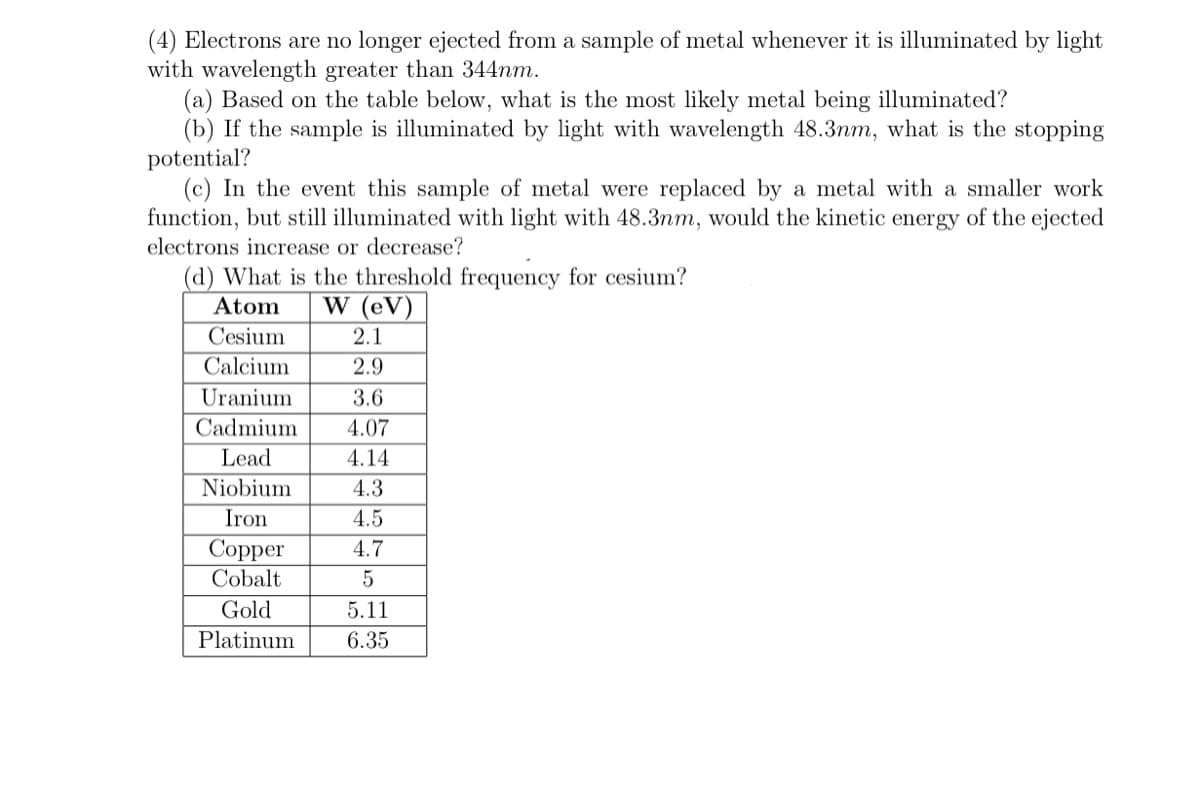(4) Electrons are no longer ejected from a sample of metal whenever it is illuminated by light with wavelength greater than 344nm. (a) Based on the table below, what is the most likely metal being illuminated? (b) If the sample is illuminated by light with wavelength 48.3nm, what is the stopping potential? (c) In the event this sample of metal were replaced by a metal with a smaller work function, but still illuminated with light with 48.3nm, would the kinetic energy of the ejected electrons increase or decrease? (d) What is the threshold frequency for cesium?
(4) Electrons are no longer ejected from a sample of metal whenever it is illuminated by light with wavelength greater than 344nm. (a) Based on the table below, what is the most likely metal being illuminated? (b) If the sample is illuminated by light with wavelength 48.3nm, what is the stopping potential? (c) In the event this sample of metal were replaced by a metal with a smaller work function, but still illuminated with light with 48.3nm, would the kinetic energy of the ejected electrons increase or decrease? (d) What is the threshold frequency for cesium?
Modern Physics
3rd Edition
ISBN:9781111794378
Author:Raymond A. Serway, Clement J. Moses, Curt A. Moyer
Publisher:Raymond A. Serway, Clement J. Moses, Curt A. Moyer
Chapter5: Matter Waves
Section: Chapter Questions
Problem 22P
Related questions
Question
Answer all parts please

Transcribed Image Text:(4) Electrons are no longer ejected from a sample of metal whenever it is illuminated by light
with wavelength greater than 344nm.
(a) Based on the table below, what is the most likely metal being illuminated?
(b) If the sample is illuminated by light with wavelength 48.3nm, what is the stopping
potential?
(c) In the event this sample of metal were replaced by a metal with a smaller work
function, but still illuminated with light with 48.3nm, would the kinetic energy of the ejected
electrons increase or decrease?
(d) What is the threshold frequency for cesium?
W (eV)
Atom
Cesium
2.1
Calcium
2.9
Uranium
3.6
Cadmium
4.07
Lead
4.14
Niobium
4.3
Iron
4.5
Copper
Cobalt
4.7
Gold
5.11
Platinum
6.35
Expert Solution
This question has been solved!
Explore an expertly crafted, step-by-step solution for a thorough understanding of key concepts.
Step by step
Solved in 2 steps with 2 images

Knowledge Booster
Learn more about
Need a deep-dive on the concept behind this application? Look no further. Learn more about this topic, physics and related others by exploring similar questions and additional content below.Recommended textbooks for you

Modern Physics
Physics
ISBN:
9781111794378
Author:
Raymond A. Serway, Clement J. Moses, Curt A. Moyer
Publisher:
Cengage Learning

Classical Dynamics of Particles and Systems
Physics
ISBN:
9780534408961
Author:
Stephen T. Thornton, Jerry B. Marion
Publisher:
Cengage Learning

Principles of Physics: A Calculus-Based Text
Physics
ISBN:
9781133104261
Author:
Raymond A. Serway, John W. Jewett
Publisher:
Cengage Learning

Modern Physics
Physics
ISBN:
9781111794378
Author:
Raymond A. Serway, Clement J. Moses, Curt A. Moyer
Publisher:
Cengage Learning

Classical Dynamics of Particles and Systems
Physics
ISBN:
9780534408961
Author:
Stephen T. Thornton, Jerry B. Marion
Publisher:
Cengage Learning

Principles of Physics: A Calculus-Based Text
Physics
ISBN:
9781133104261
Author:
Raymond A. Serway, John W. Jewett
Publisher:
Cengage Learning

University Physics Volume 3
Physics
ISBN:
9781938168185
Author:
William Moebs, Jeff Sanny
Publisher:
OpenStax

An Introduction to Physical Science
Physics
ISBN:
9781305079137
Author:
James Shipman, Jerry D. Wilson, Charles A. Higgins, Omar Torres
Publisher:
Cengage Learning